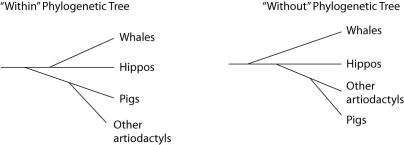Multiple Choice
Traditionally, whales and hippopotamuses have been classified in different orders, the Cetacea and the Artiodactyla, respectively. Recent molecular evidence, however, indicates that the whales' closest living relatives are the hippos. This has caused some zoologists to lump the two orders together into a single clade, the Cetartiodactyla. There is no consensus on whether the Cetartiodactyla should be accorded order status or superorder status. This is because it remains unclear whether the whale lineage diverged from the lineage leading to the hippos before or after the other members of the order Artiodactyla (pigs, camels, etc.) diverged (see Figure 26.2) .

Figure 26.2
Figure 26.2 contrasts the "Within the artiodactyls" origin of the whale lineage with the "Without the artiodactyls" origin of the whale lineage.
-Placing whales and hippos in the same clade means
A) that these organisms are phenotypically more similar to each other than to any others shown on the trees in Figure 26.2.
B) that their morphological similarities are probably homoplasies.
C) that they had a common ancestor.
D) that all three of the responses are correct.
E) that two of the responses are correct.
Correct Answer:

Verified
Correct Answer:
Verified
Q31: Traditionally, zoologists have placed birds in their
Q32: Which of the following is (are)problematic when
Q33: Which of these would, if it had
Q34: The most important feature that permits a
Q35: <img src="https://d2lvgg3v3hfg70.cloudfront.net/TB5463/.jpg" alt=" Figure 26.3.
Q37: Which of the following items does not
Q38: The following questions refer to this phylogenetic
Q39: The next questions refer to the following
Q40: Traditionally, zoologists have placed birds in their
Q41: Which kind of DNA should provide the